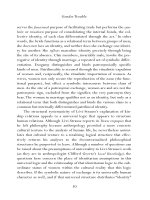GENDER TROUBLE 102
Bạn đang xem bản rút gọn của tài liệu. Xem và tải ngay bản đầy đủ của tài liệu tại đây (20.62 KB, 1 trang )
Prohibition, Psychoanalysis, and the Heterosexual Matrix
here signified as an asexual position, as indeed, a position that refuses
sexuality. For the earlier analogy with Ferenzci to become complete, it
would seem that this description enacts the “defense” against female
homosexuality as sexuality that is nevertheless understood as the reflexive structure of the “homosexual man.” And yet, there is no clear way to
read this description of a female homosexuality that is not about a sexual desire for women. Riviere would have us believe that this curious
typological anomaly cannot be reduced to a repressed female homosexuality or heterosexuality.What is hidden is not sexuality, but rage.
One possible interpretation is that the woman in masquerade
wishes for masculinity in order to engage in public discourse with men
and as a man as part of a male homoerotic exchange. And precisely
because that male homoerotic exchange would signify castration, she
fears the same retribution that motivates the “defenses” of the homosexual man. Indeed, perhaps femininity as masquerade is meant to
deflect from male homosexuality—that being the erotic presupposition of hegemonic discourse, the “hommo-sexuality” that Irigaray suggests. In any case, Riviere would have us consider that such women
sustain masculine identifications not to occupy a position in a sexual
exchange, but, rather, to pursue a rivalry that has no sexual object or,
at least, that has none that she will name.
Riviere’s text offers a way to reconsider the question: What is
masked by masquerade? In a key passage that marks a departure from
the restricted analysis demarcated by Jones’s classificatory system, she
suggests that “masquerade” is more than the characteristic of an “intermediate type,” that it is central to all “womanliness”:
The reader may now ask how I define womanliness or where I draw
the line between genuine womanliness and the ‘masquerade’. My
suggestion is not, however, that there is any such difference; whether
radical or superficial, they are the same thing. (38)
This refusal to postulate a femininity that is prior to mimicry and
the mask is taken up by Stephen Heath in “Joan Riviere and the
67









